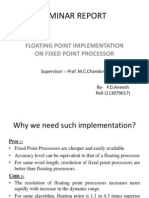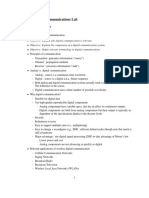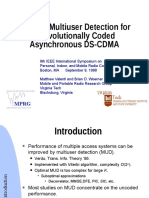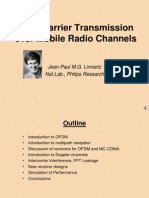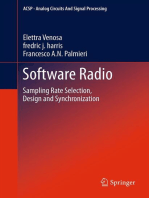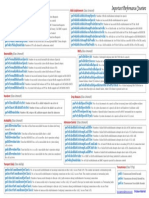Design and Analysis of LDPC For MIMO-OFDM: Guosen Yue NEC Labs Research Princeton, NJ
Design and Analysis of LDPC For MIMO-OFDM: Guosen Yue NEC Labs Research Princeton, NJ
Uploaded by
mayankardeshanaCopyright:
Available Formats
Design and Analysis of LDPC For MIMO-OFDM: Guosen Yue NEC Labs Research Princeton, NJ
Design and Analysis of LDPC For MIMO-OFDM: Guosen Yue NEC Labs Research Princeton, NJ
Uploaded by
mayankardeshanaOriginal Description:
Original Title
Copyright
Available Formats
Share this document
Did you find this document useful?
Is this content inappropriate?
Report this DocumentCopyright:
Available Formats
Design and Analysis of LDPC For MIMO-OFDM: Guosen Yue NEC Labs Research Princeton, NJ
Design and Analysis of LDPC For MIMO-OFDM: Guosen Yue NEC Labs Research Princeton, NJ
Uploaded by
mayankardeshanaCopyright:
Available Formats
Design and Analysis of LDPC for MIMO-OFDM
Guosen Yue
NEC Labs Research
Princeton, NJ
Joint work with
Ben Lu
Xiaodong Wang (Columbia Univ.)
Outline
LDPC coded MIMO OFDM
Analysis & Optimization of (irregular) LDPC Coded MIMO OFDM
A few practical issues: Dierent number of antennas; dierent MIMO demodulation
schemes; dierent spatial correlation models
Large-code-length: Optimization of degree proles by density evolution with Gaussian
approximation
Short-code-length: Random construction with girth conditioning
Numerical examples and conclusions
Problem Statement
Future personal wireless communications
A popular vision: IP-based multimedia wireless services with both ubiquitous coverage
( cellular) and high speed ( Wi-Fi).
A narrow-sense engineering vision: wireless packet IP data communications with high
throughput and low latency.
Enabling techniques for high-speed wireless packet data
PHY layer: MIMO, advanced FEC, advanced DSP, adaptive transmission, ...
MAC layer: channel-aware scheduling, multi-access, fast ARQ, interference control, ...
Networking layer, cross-layer, . . .
In this work, we focus on the peak date-rate of downlink transmission
Low-Density Parity-Check (LDPC) Codes
Invented by R. Gallager in 1962; re-discovered by Mackay & Neal in 1997, by Richardson & Shokrollahi
& Urbanke in 1999.
LDPC is a linear block code dened by a very sparse parity check matrix; or equivalently by a bipartite
(Tanner) graph (variable nodes, check nodes and connecting edges).
LDPC codes subsume a class of capacity-approaching codes, e.g., turbo codes, RA codes.
Decoding complexity of LDPC codes is lower than turbo codes, and suitable for parallel processing.
Regular LDPC codes: same number of 1s in each column and row of the sparse parity check matrix.
Irregular LDPC codes: dierent number of 1s ...... Large-code-size irregular LDPC: degree proles.
Deterministic LDPC construction: array codes [Fan 99], graph theory [Lin 02], . . .
Pseudo-random LDPC construction: convergence to ensemble average theorem for large-code-size
[Gallager 63], girth conditioning for moderate/short-code-size [Campeliot & Modha & Rajagopalan
99, Yang & Ryan 02, Tian & Jones & Villasenor & Wesel 02].
LDPC Code Optimization
Previous works on LDPC optimization
for AWGN channels by density evolution [Richardson & Shokrollahi & Urbanke, 01]
for AWGN channels by density evolution with Gaussian approx [Chung & Forney & Richardson & Urbanke, 01]
for Rayleigh fading channels by density evolution with mixture Gaussian approx [Hou & Siegel & Milstein, 01]
for ISI channels by density evolution with mixture Gaussian approx [Narayanan & Wang & Yue, 02]
for MIMO channels by EXIT Chart [tenBrink & Kramer & Ashikhmin, 02, ]
...
In this work
optimization for MIMO OFDM channels by density evolution with mixture Gaussian approx.
number of antennas and bandwidth: use of MIMO technique to support the same data rate with less bandwidth
(i.e., higher spectral eciency).
low-complexity iterative receiver: use of low-complexity soft LMMSE-SIC MIMO demodulator, as opposed to
exponentially complex soft MAP MIMO demodulator.
spatially correlated MIMO: non-full-scattering scenario (due to limited antenna separation or angle spread)
LDPC Coded MIMO OFDM for 4G Downlink
MIMO: multiple-antennas at both transmit and receive sides; establish the multi-fold
virtual air-links, the spatial resource not regulated by FCC.
OFDM: low-complexity in dispersive channels; easy bond with multiuser scheduler; a highly
competitive solution for (synchronous) downlink transmission.
LDPC: capacity-approaching; low-complexity & parallizable decoder; freedom for design
and performance optimization.
.
.
.
LDPC
Encoder Modulator
MPSK
Bits Symbols
Coded
IFFT
IFFT
IFFT
Info. Coded
S/P
Bits
.
.
.
FFT
FFT
FFT
e
1
1
2
M
Turbo iterative demodulation & decoding
Demod.
Soft LDPC
Decoder
Decision
Info. Bits
e
2
Turbo Iterative Demodulation and Decoding
[1] Iteration of turbo receiver: For q = 1, 2, . . . , Q
[1-a] Soft MIMO OFDM demodulation: L
q
DL
[b
i
] = g({r(t)}, {L
q1
DL
[b
j
]}
j
),
[1-b] Soft LDPC decoding: For p = 1, 2, . . . , P
Sum-product algorithm: for all variable nodes and check nodes
Variable node update: L
p,q
bc
(e
b
i,j
) = L
q
mL
[b
k
(i)] +
i
n=1,n=j
L
p1,q
bc
(e
b
i,n
).
Check node update: L
p,q
bc
(e
c
i,j
) = 2 tanh
1
_
i
n=1,n=j
tanh
_
L
p,q
bc
(e
c
i,n
)
2
__
.
[1-c] Compute extrinsic messages passed back to the multiuser detector:
L
q
DL
[b
i
] =
n=1
L
P,q
bc
(e
b
i,n
).
[2] Final hard decisions on information and parity bits:
b
i
= sign
_
L
Q
DL
[b
i
] + L
Q
DL
[b
i
]
_
.
Analysis & Optimization of LDPC Coded MIMO OFDM
Degree proles of LDPC: (x) =
d
lmax
i=1
i
x
i1
and (x) =
d
rmax
i=1
i
x
i1
Optimization problem
(
(x),
(x)) = arg min
(x),(x)
SNR :
_
L
Q
DL
[b
i
] + L
Q
DL
[b
i
]
_
.
Basic idea: track the dynamics of turbo iterative demodulation and decoding.
Major assumptions and approximations
Assume the extrinsic LLR at each variable node or check node of LDPC codes is Gaussian and
symmetric, i.e., N(m, 2m).
Assume the LLR from LDPC decoder to MIMO demodulator as mixture Gaussian f
q
DL
d
l
,max
j=2
j
N(m
j
, 2m
j
). due to sum-product algorithm
Approx the LLR from MIMO demodulator to LDPC decoder as mixture Gaussian f
q
DL
J
i=1
i
N(m
i
, 2m
i
). using EM algorithm
We then only need to track parameters of mixture Gaussians, {
i
, m
i
}
i
, rather than complete pdfs.
Analysis & Optimization of LDPC MIMO OFDM
Turbo receiver iterations: For q = 1, 2, . . . , Q
Mixture Gaussian approx of extrinsic LLR of MIMO demodulator:
f
q
DL
=
J
j=1
j
N(
j
, 2
j
)
Mixture Gaussian approx of extrinsic LLR of LDPC decoder:
2 Iterate between variable node update and check node update: For p = 1, 2, . . . , P
At a bit node of degree i:
f
p,q
bc
=
J
j=1
d
l,max
i=2
i
N
_
j
+ (i 1)m
p1,q
bc
, 2[
j
+ (i 1)m
p1,q
bc
]
_
At check node of degree j:
f
p,q
bc
=
dr,max
j=2
j
N
_
m
p,q
bc,j
, 2m
p,q
bc,j
_
2 Message passed back to the multiuser detector:
f
P,q
DL
=
d
l,max
i=2
i
N (m
q
DL
(i), 2m
q
DL
(i))
The optimized SNR threshold
(
(x),
(x)) = arg min
(x),(x)
SNR :
_
L
Q
DL
[b
i
] + L
Q
DL
[b
i
]
_
.
Performance in Ergodic Channels w/o Spatial Correlation
Within 1.0 dB from channel capacity
0 0.5 1 1.5 2 2.5 3 3.5 4
10
6
10
5
10
4
10
3
10
2
10
1
Large size LDPC code (n=880,640), 1x1 Uncorrelated MIMOOFDM
SNR (dB)
B
i
t
E
r
r
o
r
R
a
t
e
(
B
E
R
)
Capacity
MAP+reg_LDPC D.E.
MAP+reg_LDPC Simu
SIC+reg_LDPC D.E.
SIC+reg_LDPC Simu
MAP+irr_LDPC D.E.
MAP+irr_LDPC Simu
SIC+irr_LDPC D.E.
SIC+irr_LDPC Simu
Figure 1: Large-block-size LDPC in 1 1 MIMO OFDM.
Performance in Ergodic Channels w/o Spatial Correlation
Within 1.0 dB from channel capacity
0 0.5 1 1.5 2 2.5 3 3.5 4
10
6
10
5
10
4
10
3
10
2
10
1
Large size LDPC code (n=880,640), 4x4 Uncorrelated MIMOOFDM
SNR (dB)
B
i
t
E
r
r
o
r
R
a
t
e
(
B
E
R
)
Capacity
MAP+reg_LDPC D.E.
MAP+reg_LDPC Simu
SIC+reg_LDPC D.E.
SIC+reg_LDPC Simu
MAP+irr_LDPC D.E.
MAP+irr_LDPC Simu
SIC+irr_LDPC D.E.
SIC+irr_LDPC Simu
Figure 2: Large-block-size LDPC in 4 4 MIMO OFDM.
Performance in Ergodic Channels with Spatial Correlation
LMMSE-SIC demodulator suers extra loss due to spatial correlation
2 2.5 3 3.5 4 4.5 5 5.5 6
10
6
10
5
10
4
10
3
10
2
10
1
Large size LDPC code (n=880,640), 4x4 Correlated MIMOOFDM
SNR (dB)
B
i
t
E
r
r
o
r
R
a
t
e
(
B
E
R
)
Capacity
MAP+reg_LDPC D.E.
MAP+reg_LDPC Simu
SIC+reg_LDPC D.E.
SIC+reg_LDPC Simu
MAP+irr_LDPC D.E.
MAP+irr_LDPC Simu
SIC+irr_LDPC D.E.
SIC+irr_LDPC Simu
Figure 3: Large-block-size LDPC in 4 4 MIMO OFDM.
Performance in Outage Channels
Within 1.5 dB from channel capacity
0 1 2 3 4 5 6 7 8 9
10
3
10
2
10
1
10
0
Small size LDPC code (n=2048), 4x4 Uncorrelated MIMOOFDM
F
r
a
m
e
E
r
r
o
r
R
a
t
e
SNR (dB)
Capacity
MAP+reg_LDPC
SIC+reg_LDPC
MAP+irr_LDPC
SIC+irr_LDPC
Figure 4: Short-block-size LDPC in 4 4 MIMO OFDM, target FER of 10
2
.
Performance in Outage Channels:
Convergence of Turbo Iterative Receiver
Irregular LDPC expedites the convergence of overall turbo receiver
1.5 2 2.5 3 3.5 4 4.5 5 5.5
4.5
5
5.5
6
6.5
7
Small size LDPC code (n=2048), 4x4 Uncorrelated MIMOOFDM
R
e
q
u
i
r
e
d
S
N
R
t
o
a
c
h
i
e
v
e
F
E
R
o
f
1
0
2
(
d
B
)
Number of turbo receiver iteration
MAP+reg_LDPC
SIC+reg_LDPC
MAP+irr_LDPC
SIC+irr_LDPC
Figure 5: Short-block-size LDPC in 4 4 MIMO OFDM, target FER of 10
2
.
Gain of Channel-Specic LDPC Design
Design gain of MIMO-OFDM-optimized LDPC increases for larger number of antennas, as
compared to AWGN-optimized LDPC.
Large Block Irregular LDPC Small Block Irregular LDPC
SNR (dB) LDPC.I LDPC.II Channel-specic Design LDPC.I LDPC.II Channel-specic Design
Gain (LDPC.II - LDPC.I) Gain (LDPC.II - LDPC.I)
MAP (1 1) 2.57 2.57 0.00 7.08 7.08 0.00
MAP (2 2) 2.56 2.61 0.05 5.57 5.72 0.15
MAP (4 4) 2.46 2.65 0.19 4.48 4.81 0.33
SIC (1 1) 2.52 2.52 0.00 7.06 7.06 0.00
SIC (2 2) 2.75 2.92 0.17 6.32 6.44 0.12
SIC (4 4) 2.82 3.17 0.35 5.33 5.70 0.37
LDPC.I: Performance of MIMO-OFDM-optimized LDPC in MIMO-OFDM channels.
LDPC.II: Performance of AWGN-optimized LDPC in MIMO-OFDM channels.
Summary
LDPC coded MIMO OFDM is capable of supporting 4G wireless packet data transmission
with higher spectral eciency which translates into either bandwidth saving or further
data rate increase.
In ergodic channels, channel-specic (irregular) LDPC optimization results in larger SNR
gain in systems with larger number of antennas.
In outage channels, irregular LDPC codes lead to faster receiver convergence.
LMMSE-SIC based receiver performs near-optimal in spatially uncorrelated MIMO OFDM
channels; but suers additional loss in MIMO channels with severe spatial correlation.
You might also like
- Difference Between Curves v1.2Document12 pagesDifference Between Curves v1.2Guilherme GomesNo ratings yet
- Module 2 - DecibelsDocument7 pagesModule 2 - DecibelsAira Mae CrespoNo ratings yet
- Project of Various Technical Activities in Doordarshan KendraDocument35 pagesProject of Various Technical Activities in Doordarshan KendraSYED MOHAMMAD FAIZNo ratings yet
- Lubi TransformDocument7 pagesLubi TransformShanmuga SundaramNo ratings yet
- LDPC ThesisDocument131 pagesLDPC ThesisRamy MedhatNo ratings yet
- A Simplified Min-Sum Decoding Algorithm For Non-Binary LDPC CodesDocument9 pagesA Simplified Min-Sum Decoding Algorithm For Non-Binary LDPC Codessweet2shineNo ratings yet
- LDPCDocument20 pagesLDPCKshitija PendkeNo ratings yet
- VLSI Signal Processing Basics and Iteration Bound K.K. ParhiDocument49 pagesVLSI Signal Processing Basics and Iteration Bound K.K. ParhiDhruv2110100% (1)
- Digital 3Document81 pagesDigital 3Mohamed TarkasNo ratings yet
- Low Density Parity Check Codes1Document41 pagesLow Density Parity Check Codes1Prithvi RajNo ratings yet
- GPS Signal Structure: - SourcesDocument23 pagesGPS Signal Structure: - Sourcessoumya_cu100% (2)
- SeminarDocument12 pagesSeminarPD AneeshNo ratings yet
- FPGA Implementation of LDPC Decoder Architecture For Wireless Communication StandardsDocument4 pagesFPGA Implementation of LDPC Decoder Architecture For Wireless Communication StandardsArgyrios KokkinisNo ratings yet
- DSPDocument190 pagesDSPMallikarjun AralimaradNo ratings yet
- Adsp Lab Manual-1Document24 pagesAdsp Lab Manual-1Damai VenkatadriNo ratings yet
- Implementation Issues For Channel Estimation and Detection Algorithms For W-CDMADocument41 pagesImplementation Issues For Channel Estimation and Detection Algorithms For W-CDMASignum FunctionNo ratings yet
- Basic-Set Trellis Min-Max Decoder Architecture For Nonbinary LDPC Codes With High-Order Galois FieldsDocument12 pagesBasic-Set Trellis Min-Max Decoder Architecture For Nonbinary LDPC Codes With High-Order Galois FieldskamalbazeerNo ratings yet
- Asst. Prof. Anindita Paul: Mintu Kumar Dutta Sudip Giri Saptarshi Ghosh Tanaka Sengupta Srijeeta Roy Utsabdeep RayDocument38 pagesAsst. Prof. Anindita Paul: Mintu Kumar Dutta Sudip Giri Saptarshi Ghosh Tanaka Sengupta Srijeeta Roy Utsabdeep RayUtsav Determined RayNo ratings yet
- 3-Discrete Cosine Transform PDFDocument87 pages3-Discrete Cosine Transform PDFHiteshNo ratings yet
- Convolutional Codes Turbo Codes LDPC CodesDocument49 pagesConvolutional Codes Turbo Codes LDPC CodesveerutheprinceNo ratings yet
- High-Speed OpticalDocument4 pagesHigh-Speed OpticalRini KamilNo ratings yet
- DVBS StandardDocument21 pagesDVBS StandardPelayo Gacía BárcenaNo ratings yet
- Basics of Spread SpectrumDocument34 pagesBasics of Spread Spectrumapi-3708342100% (1)
- GPS SignalsDocument23 pagesGPS Signalskrishna144No ratings yet
- Ee4105 Wcdma NewDocument105 pagesEe4105 Wcdma NewJeffGan LkNo ratings yet
- Coded Modulation in Optical Communications: Otho1.Pdf Otho1 PDFDocument3 pagesCoded Modulation in Optical Communications: Otho1.Pdf Otho1 PDFAnthony WellsNo ratings yet
- Difference To Sum Ratio Factor Based Min-Sum Decoding For Low Density Parity Check CodesDocument6 pagesDifference To Sum Ratio Factor Based Min-Sum Decoding For Low Density Parity Check CodesMishuk MawlaNo ratings yet
- 5.g 133 - Efficient Fault Effect Extraction For An IntegratedDocument4 pages5.g 133 - Efficient Fault Effect Extraction For An IntegratedVančo LitovskiNo ratings yet
- LDPCDocument40 pagesLDPCAli Subhi Al-SadiNo ratings yet
- DWC-USRP - LectureNotes PDFDocument84 pagesDWC-USRP - LectureNotes PDFJesús Mendoza PadillaNo ratings yet
- BITS Pilani: Digital Signal ProcessingDocument73 pagesBITS Pilani: Digital Signal Processingaditi_nangia_1No ratings yet
- Digital Television Terrestrial Multimedia Broadcasting (DTMB) - A New Itu-R DTV Terrestrial Broadcasting Standard For China and Other MarketsDocument37 pagesDigital Television Terrestrial Multimedia Broadcasting (DTMB) - A New Itu-R DTV Terrestrial Broadcasting Standard For China and Other MarketsKashif Aziz AwanNo ratings yet
- Wireless Chp7Document13 pagesWireless Chp7Mohammed JunedNo ratings yet
- Communication ManualDocument47 pagesCommunication ManualAbinav anilNo ratings yet
- RC LDPC Dec OpexDocument7 pagesRC LDPC Dec OpexAyodele Emmanuel SonugaNo ratings yet
- GSM Physical LayerDocument25 pagesGSM Physical LayerW@2nNo ratings yet
- MC CDMA PAPR Reduction Using Discrete Logarithmic Method: B.Sarala, D.S.Venketeswarlu2, B.N.BhandariDocument6 pagesMC CDMA PAPR Reduction Using Discrete Logarithmic Method: B.Sarala, D.S.Venketeswarlu2, B.N.BhandariIJERDNo ratings yet
- Comm Chptr4Document53 pagesComm Chptr4Muhamad Fuad100% (1)
- Department of Electrical and Electronics EngineeringDocument12 pagesDepartment of Electrical and Electronics EngineeringMalik ZaidNo ratings yet
- Iterative Multiuser Detection For Convolutionally Coded Asynchronous DS-CDMADocument21 pagesIterative Multiuser Detection For Convolutionally Coded Asynchronous DS-CDMAvasantha priyankaNo ratings yet
- Multi-Carrier Transmission Over Mobile Radio Channels: Jean-Paul M.G. Linnartz Nat - Lab., Philips ResearchDocument48 pagesMulti-Carrier Transmission Over Mobile Radio Channels: Jean-Paul M.G. Linnartz Nat - Lab., Philips ResearchAsad BashadiNo ratings yet
- 2 DS-CDMA With MRC: U U I I IDocument5 pages2 DS-CDMA With MRC: U U I I INasir KhanNo ratings yet
- Efficient and Low-Complexity Chromatic Dispersion Estimation in Coherent Optical SystemsDocument4 pagesEfficient and Low-Complexity Chromatic Dispersion Estimation in Coherent Optical SystemsNguyễn Thanh TâmNo ratings yet
- Lecture Mian Ahmed Yaser TSE PCMDocument49 pagesLecture Mian Ahmed Yaser TSE PCMAliImranNo ratings yet
- Dvb-t2 Master ThesisDocument5 pagesDvb-t2 Master Thesishollyvegacorpuschristi100% (2)
- DE63 Dec 2012Document6 pagesDE63 Dec 2012Rakesh RajbharNo ratings yet
- OFDM Simulation EE810Document18 pagesOFDM Simulation EE810Ashique Mahmood100% (1)
- Department of Electrical and Electronics EngineeringDocument14 pagesDepartment of Electrical and Electronics EngineeringMalik ZaidNo ratings yet
- Turbo Codes: R.Sunder, Assistant Professor, Department of Electronics and Communication EngineeringDocument51 pagesTurbo Codes: R.Sunder, Assistant Professor, Department of Electronics and Communication EngineeringDigvijay KarasiNo ratings yet
- Design Considerations of The RF Front-End For High Dynamic Range Digital Radar ReceiversDocument4 pagesDesign Considerations of The RF Front-End For High Dynamic Range Digital Radar ReceiversNuman KayaNo ratings yet
- Intro LDPCDocument19 pagesIntro LDPCHarsh ShrimalNo ratings yet
- TTICLDPCCDocument4 pagesTTICLDPCCPham Thanh PhuNo ratings yet
- Digital Communications: Lab Manual (Student Copy)Document78 pagesDigital Communications: Lab Manual (Student Copy)dhileepan DilipNo ratings yet
- Scalable and Low Power LDPC Decoder Design Using High Level Algorithmic SynthesisDocument4 pagesScalable and Low Power LDPC Decoder Design Using High Level Algorithmic Synthesisig77No ratings yet
- Week9a, Digital ModulationDocument39 pagesWeek9a, Digital ModulationMulie1972No ratings yet
- Low Density Parity Check Codes in OFDM System: Dileep M.K, Aravind Iyengar, Andrew Thangaraj, Srikrishna BhashyamDocument5 pagesLow Density Parity Check Codes in OFDM System: Dileep M.K, Aravind Iyengar, Andrew Thangaraj, Srikrishna BhashyammalhiavtarsinghNo ratings yet
- WCDMA RAN FundamentalsDocument56 pagesWCDMA RAN FundamentalsowuorjaredNo ratings yet
- Performance Analysis and Design Optimization of LDPC-Coded MIMO OFDM SystemsDocument14 pagesPerformance Analysis and Design Optimization of LDPC-Coded MIMO OFDM SystemsThao ChipNo ratings yet
- CELPDocument23 pagesCELPANeek181No ratings yet
- Kasraian ECET375 Week2Document42 pagesKasraian ECET375 Week2Raul PerdomoNo ratings yet
- Software Radio: Sampling Rate Selection, Design and SynchronizationFrom EverandSoftware Radio: Sampling Rate Selection, Design and SynchronizationNo ratings yet
- Radio Frequency Identification and Sensors: From RFID to Chipless RFIDFrom EverandRadio Frequency Identification and Sensors: From RFID to Chipless RFIDNo ratings yet
- Enabling Technologies for High Spectral-efficiency Coherent Optical Communication NetworksFrom EverandEnabling Technologies for High Spectral-efficiency Coherent Optical Communication NetworksNo ratings yet
- Chapter 7 - Poisson's and Laplace EquationsDocument11 pagesChapter 7 - Poisson's and Laplace EquationsmayankardeshanaNo ratings yet
- Chapter 1 - Vector AnalysisDocument27 pagesChapter 1 - Vector AnalysismayankardeshanaNo ratings yet
- Syllabus RF System DesignDocument9 pagesSyllabus RF System DesignmayankardeshanaNo ratings yet
- Cyber Physical System: Architecture, Applications and Research ChallengesDocument12 pagesCyber Physical System: Architecture, Applications and Research ChallengesmayankardeshanaNo ratings yet
- MMICDocument16 pagesMMICmayankardeshana100% (1)
- LDPC Options For Next Generation Wireless Systems: T. Lestable and E. ZimmermannDocument10 pagesLDPC Options For Next Generation Wireless Systems: T. Lestable and E. ZimmermannmayankardeshanaNo ratings yet
- Ahuja PSX-1200 SPDocument2 pagesAhuja PSX-1200 SPdhirajkumar_1No ratings yet
- Intrusion Core Product List May2005Document11 pagesIntrusion Core Product List May2005MaFer CastellanoNo ratings yet
- 15 Enablence Datasheet Ocsd Awg Standard 88channel 50ghzDocument5 pages15 Enablence Datasheet Ocsd Awg Standard 88channel 50ghzlitoduterNo ratings yet
- Assignment On Wireline and Wireless CommunicationsDocument2 pagesAssignment On Wireline and Wireless Communicationsmohansharma_99No ratings yet
- NASA Facts The Advanced Communications Technology Satellite (ACTS) A Switchboard in The SkyDocument8 pagesNASA Facts The Advanced Communications Technology Satellite (ACTS) A Switchboard in The SkyBob AndrepontNo ratings yet
- Cu5301 - MWCDocument21 pagesCu5301 - MWCArul King100% (2)
- RAY 53 DSC VHF RaymarineDocument45 pagesRAY 53 DSC VHF RaymarineOkan TaktakoğluNo ratings yet
- CE 715 Communication Engineering Lab: Presented byDocument73 pagesCE 715 Communication Engineering Lab: Presented byTessy AkNo ratings yet
- BXV 80090 8CF R1Document1 pageBXV 80090 8CF R1Francisco NascimentoNo ratings yet
- Microstrip - Square Patch Design FormulasDocument5 pagesMicrostrip - Square Patch Design FormulasTfNo ratings yet
- 3G Handover OptimizationDocument12 pages3G Handover OptimizationTarek GARA100% (2)
- Lecture HandoutsDocument3 pagesLecture Handoutshari vigneshNo ratings yet
- 3GPP TS 33.501Document262 pages3GPP TS 33.501Vinayakam ChellappanNo ratings yet
- Ft-991a Wires-X Eng 1712-C PDFDocument15 pagesFt-991a Wires-X Eng 1712-C PDFcraigerrington8911No ratings yet
- Attenuator Convection Cooled DSDocument4 pagesAttenuator Convection Cooled DShennrynsNo ratings yet
- Avionics CatelogDocument9 pagesAvionics CatelogTharaka Munasinghe100% (1)
- Cellular Frequency Spectrum: Uplink (Reverse) Paths Downlink (Forward) PathsDocument3 pagesCellular Frequency Spectrum: Uplink (Reverse) Paths Downlink (Forward) Pathsmau_mmx5738No ratings yet
- A Modular Antenna For UHF RFID Near-Field Desktop Reader: R. Caso, A. Michel, A. Buffi, P. Nepa G. IsolaDocument4 pagesA Modular Antenna For UHF RFID Near-Field Desktop Reader: R. Caso, A. Michel, A. Buffi, P. Nepa G. IsolaPeerawit AunruanNo ratings yet
- The Impact of Current Transformer Saturation On The Distance ProtectionDocument5 pagesThe Impact of Current Transformer Saturation On The Distance ProtectionFabien CallodNo ratings yet
- Taylor Smith - How Microphones WorkDocument5 pagesTaylor Smith - How Microphones WorktaylorNo ratings yet
- IFAC SYSID09 Schoukens BenchmarkDocument4 pagesIFAC SYSID09 Schoukens BenchmarkHamid HamouchiNo ratings yet
- Radiation Meters EMR-200, EMR-300Document4 pagesRadiation Meters EMR-200, EMR-300Andy MeyerNo ratings yet
- Ringing On A Transmission LineDocument33 pagesRinging On A Transmission LinePrem BhaskaraNo ratings yet
- Design of Computationally Efficient 2D FIR Filters Using Sampling-Kernel-Based Interpolation and Frequency TransformationDocument2 pagesDesign of Computationally Efficient 2D FIR Filters Using Sampling-Kernel-Based Interpolation and Frequency TransformationHitendra SinghNo ratings yet
- GpsDocument35 pagesGpsaslamNo ratings yet
- 442 Revised Lab Manual w07Document51 pages442 Revised Lab Manual w07srinu247No ratings yet
- 3G Imp Counters PDFDocument1 page3G Imp Counters PDFKhushbu ShahNo ratings yet











